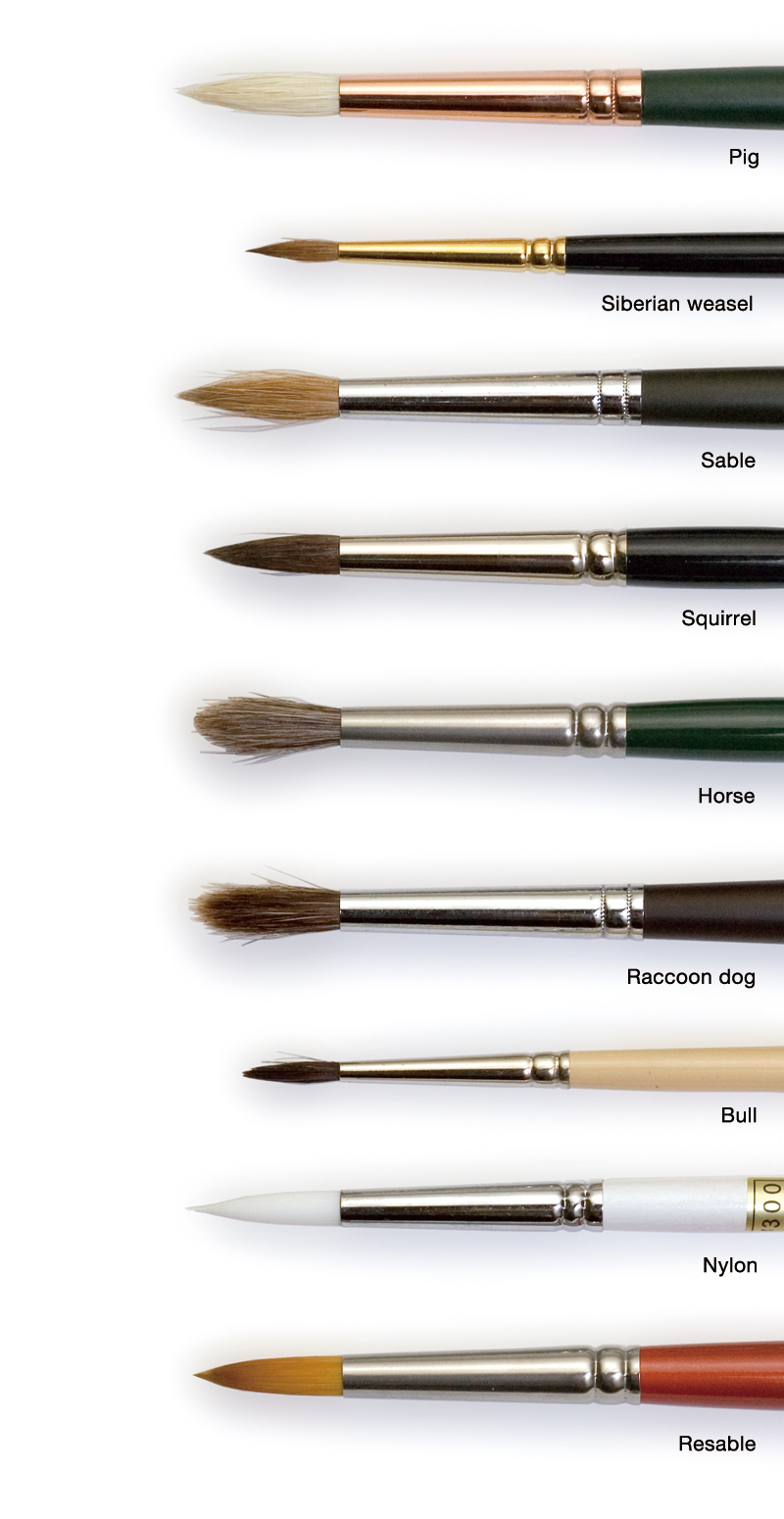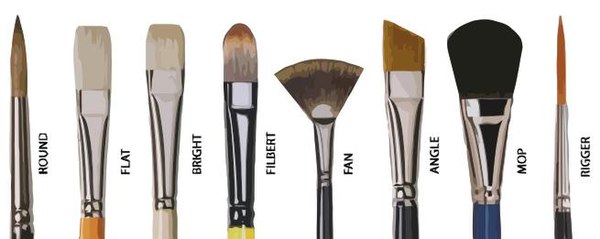When you’re faced with a wall full of paint brush options and terms like “flat”, “angled”, “Chinex” and “nylon/polyester,” it can be confusing to know which paint brush is right for your job. Different projects and paint products work best with certain types, sizes and qualities of paint brushes. We sat down with our McCormick Paints Rockville Store Manager, Todd, to find out what brush a real paint pro would recommend, depending on your particular paint project and need.
Purdy 144153320 XL Series. Why we like it: The Purdy XL series is the best set of paint brushes in. Painting; Buyer’s Guide: Paint Brushes Use our top tips and recommendations to find paint brushes of the right size, shape, and bristle material for the DIY projects on your to-do list.
When choosing a paint brush for your painting project, answer these three questions to help lead you to the best brush for your job.
1. What type of paint or coating are you using?
Oil Based Paints –
If you are using an oil based paint for your project, such as McCormick Paints Cote-All, then look for a China bristle brush. This type of brush should be cleaned using paint thinner.
Oil Based Stains–
When working with oil based stains like McCormick Brand stains or certain Old Masters products, such as their Wiping Stain, use a China bristle paint brush.
Latex Based Paints –
When painting with a latex based paint, like McCormick Paints Generation, REVO or Advantage, use a nylon/polyester paint brush. These types of brushes should be cleaned using soap and water.
Water Based Stains/ Water Based Polyurethanes –
Use a nylon/polyester paint brush when working with water based stains or polyurethanes, like Old Masters products.
Tip from Todd: Some brushes might claim to be okay for use with all types of paint. If you choose to purchase one of these brushes, you should still only use it with one type of paint. Switching between different types of paint with the same brush could be compromise the performance of the brush.
2. What areas are you painting?
Doorways or Trim:
Use a smaller brush for these tighter areas. Look for a brush 1.5”-2” in width.
Cutting-In from Ceiling to Wall or from Wall to Trim:
You can use a larger brush for these areas, but make sure it’s a size that feels right for you and that you can easily control. A 2” -2.5” brush works well for these areas.
Larger Areas:
When you have a larger area to paint, but can’t access it with a roller, you should choose a larger, flat paint brush for these production areas as opposed to an angled brush that works well for cutting-in.
Tip from Todd: Choose a brush based on how it feels when you hold it. The larger brushes (3”) are best for more experienced painters as the larger the brush the more control that is required. Various handle lengths and handle diameters are available to suit your individual comfort preferences.
3. How long do you intend to keep the paint brush?
Long Term Use:
Invest in a high quality brush that will last a long time. A higher end paint brush will generally have more densely packed bristles, which means it will hold more paint and go further. When you invest in a high quality brush from our Premium brush section, be sure to properly clean and care for your brush so that it works well over time. Save the cardboard sleeve (called a “keeper”) to store your brush; this will protect the bristles and keep the brush nicely formed for your next use.
1-2 Uses:
Types Of Art Paint Brushes
If you don’t intend to re-use the paint brush once your job is over, then look for a brush in our Professional or Value brush section. These brushes, such as the McCormick Brand paint brushes, are affordable and will get the job done.
One Time Use:
Consider using a chip brush when applying Kwik paste paint remover, or a foam brush when applying a McCormick paint sample. These can be thrown away after they’re used.
Tip from Todd: A Chinex brush, such as the WOOSTER Chinex FTP, is a great option for oil or latex based paint projects. It’s more densely packed white bristles will hold more paint and it’s a longer lasting brush.
If you’re still not sure which brush you need, or have specific questions on paint brushes, contact your local McCormick Paints store for recommendations.
If you are a newbie to the world of painting then, first of all, we would like to welcome you to this wonderful world of art. This art of painting is like a magic where you will be able to explore the world beyond imagination and get to play with colors you might have never even seen before. And to make this magic possible you will need a magic wand. What this magic wand is? You guessed it right! I am talking about the paint brush you will need while filling that canvas with your creativity. So let’s find out more about these Different Types of Paint Brushes and learn about their Names and their Use.
Mostof the magic that you create while painting is due to the way you maneuver thepaint brush. So there is no doubt why the paint brush is one of the most belovedtools of an artist. If you are new to this realm of painting then the firstthing you should know is what kind of brush you should use. Now, that can be abit daunting if you don’t know much about the paint brushes. But why worry whenyou can simply learn all about different types of paint brushes right here!
The painting brushes come in varying sizes and shapes with different bristles. Each of these is used for different purposes and gives details to the painting in their own unique ways. Choosing the painting brush depends upon what kind of details and strokes you want in your painting.
WashBrush
Anacrylic wash brush is the biggest of the lot with a square end and medium tolong hairs. It is ideal for varnishing because it gives the maximum coveragesmoothly and quickly what with it being thicker than any other brushes. Itgives nice bold strokes and its edge can be used to create fine lines, straightedges, and stripes.
AngledBrush
Asthe name suggests the angled brush has an angled or slanted tip. This is thereason why it is also known as the slanted brush. Some might even call itshader due to its flexibility when it comes to filling small areas to biggerones without any effort. It is a perfect brush for curved strokes and fillingcorners.
What Are The Different Types Of Paint Brushes
FlatBrush
Thinkof flat brush as the mini version of the wash brush. Where the wash brush hasbristles with slightly round edges and is very thick, the flat brush is not somuch. The flat brush is perfect to use when you want a lot of paint coverageand the surface you are working on is small for a wash brush. Not to mentionthat this brush will allow you to maneuver it more easily.


FanBrush
A fan brush looks exactly like the name suggests – a fan. It is flat and has spread hairs and is an ideal choice when you are planning to paint nature elements and landscapes. It can even be used for blending backgrounds or adding subtle highlights to darker areas. You can pick a fan brush with natural hairs which are great for smoothing, blending and feathering or else opt for synthetic hairs for interesting textural effects and leaves on trees.
RoundBrush
:max_bytes(150000):strip_icc()/sb10064798n-001-56a6e6d13df78cf77290d9a3.jpg)

Imagineyou holding a pencil and that is what you will feel while holding a roundbrush. It gives you more control over the flow of paint with it being narrower thanany other brushes. The round brush can mainly be of two different types. One isthe simple round brush with a sharp point which allows you to paint fine linesand details with it. The other round brush will be narrower even than the roundbrush with a more sharply pointed tip. It is excellent to get fine lines anddetails in delicate areas.
LinerBrush
Ifyou think no other brush can be thinner than a round brush then you are so verywrong. A liner brush, also known as rigger brush, is a thin brush with verylong bristles. The tip of this brush can be flat or square and if it is angledthen it is called a sword brush. When you want to create very fine and thinlines, this is the brush that you will need to pick. Since the brush has a verysmall tip, it is often used to write out letters and numbers. Artists mostlyuse this brush to sign their work. And believe it or not, but this extremelythin brush can hold a great deal of fluid paint.
All Types Of Painting Brushes

FilbertBrush
A filbert brush is a type of flat brush which has medium to long hairs that come to a rounded point or an oval-shaped end. It gives a lovely thin line when used on its side and paints broad brushstrokes when used flat. It is a hybrid of round and flat brushes and has both of their best features – it can give details to your work as the round brushes and cover more space like the flat brush. With its variety of marks, the filbert brush has become the favorite of many artists, especially the figurative painters.
Different Types Of Oil Painting Brushes
Now that you know all about these different types of paint brushes, you wouldn’t get flustered in the paint brush aisle in an art store. Just pick the one that you feel the most comfortable with and explore your creativity. And let the worries go away and have fun with this color play!
